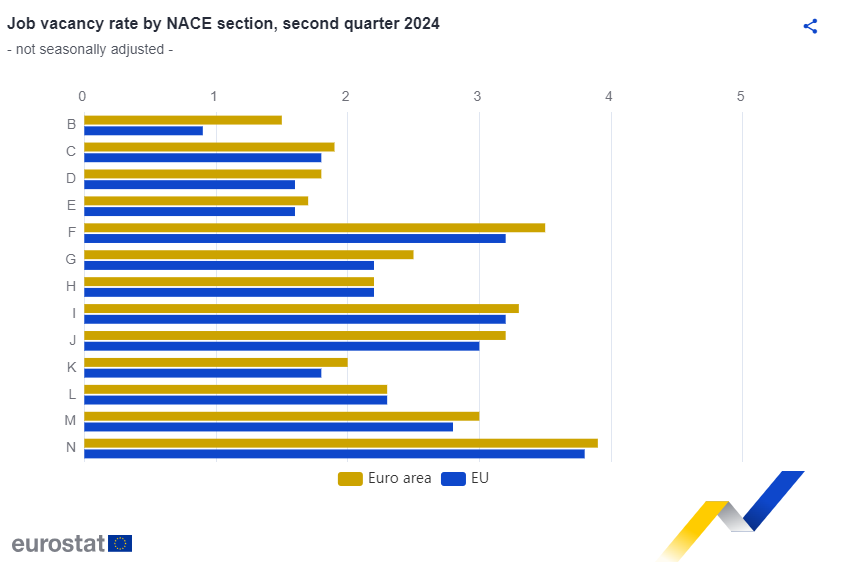Euro area job vacancy rate at 2.6%
In the euro area, the job vacancy rate in the second quarter of 2024 was
-
2.3% in industry and construction, and
-
2.9% in services.
In the EU, the rate was
-
2.2% in industry and construction, and
-
2.7% in services.
Job vacancy rate by Member States
Among the Member States for which comparable data are available (see country notes), the highest job vacancy rates in the second quarter of 2024 were recorded in Belgium , the Netherlands (4.4% in both of them) and Austria (4.0%). By contrast, the lowest rates were observed in Romania (0.7%), Bulgaria (0.8%), Poland and Spain (0.9% in both of them).
Compared with the same quarter of the previous year, the job vacancy rate increased in six Member States, remained stable in three Member States and decreased in eighteen Member States. The largest increase was observed in Greece (+0.9 pp). The largest decreases were recorded in Germany (-1.0 pp), Austria (-0.9 pp), and Sweden (-0.8 pp).
Breakdown by economic activity
The figure below presents the job vacancy rates of the EU and the euro area by economic activity, in the second quarter of 2024. Data are displayed for the business economy, for which data are available from all EU countries. The highest job vacancy rates, for both the EU and the euro area, were recorded in:
-
Section N: “Administrative and support service activities” that includes temporary employment agencies (3.9% in the euro area, 3.8% in the EU),
-
Section F: “Construction” (3.5% in the euro area, 3.2% in the EU),
-
Section I: “Accommodation and food service activities” (3.3% in the euro area, 3.2% in the EU),
-
Section J: “Information and communication” (3.2% in the euro area, 3.0% in the EU), and
-
Section M: “Professional, scientific and technical activities” (3.0% in the euro area, 2.8% in the EU)

Source: Eurostat
Legal Notice: The information in this article is intended for information purposes only. It is not intended for professional information purposes specific to a person or an institution. Every institution has different requirements because of its own circumstances even though they bear a resemblance to each other. Consequently, it is your interest to consult on an expert before taking a decision based on information stated in this article and putting into practice. Neither Karen Audit nor related person or institutions are not responsible for any damages or losses that might occur in consequence of the use of the information in this article by private or formal, real or legal person and institutions.






